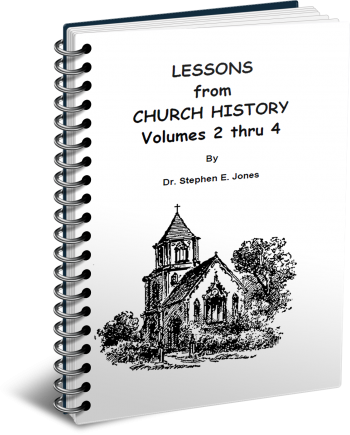Latest Posts
View the latest posts in an easy-to-read list format, with filtering options.

Volumes 2-4. This is the history of the Church from the Roman War (66-73 A.D.) to Constantine and the Council of Nicea in 325 A.D. with lessons to be learned from it.
Category - History and Prophecy

Ignatius, bishop of Antioch, was martyred probably in 113 A.D. at the beginning of the second century. He was born about 30 A.D. and was reputed to be the child in Matthew 18:2, 3,
{Matthew 18:2} 2 And he called a child to Himself and set him before them, {Matthew 18:3} 3 and said, “Truly I say to you, unless you are converted and become like children, you shall not enter the kingdom of heaven.”
As a child, he was also one of the 500 witnesses (1 Cor. 15:6) who saw Jesus in the flesh after His resurrection. In his letter to the Smyrneans, Ignatius writes in the longer version of chapter III,
“And I know that He was possessed of a body not only in His being born and crucified, but I also know that He was so after His resurrection, and believe that He is so now.”
Jerome had a copy of this in the early fifth century that apparently read a little differently:
“In this last he [Ignatius] bore witness to the Gospel which I have recently translated, in respect of the person of Christ, saying, 'I indeed saw him in the flesh after the resurrection, and I believe that he is'.”
Ignatius writes extensively to prove the major issue of the day, that Jesus had indeed come in the flesh. In this he reflects the concerns of the Apostle John, who was his primary teacher and mentor. Gnosticism was the main heresy of that time, and Ignatius refers to Jesus' appearance to the disciples in Luke 24, where He appeared to them after His resurrection having “flesh and bones” and even ate with them. For example, he wrote in ch. III,
“And after His resurrection He did eat and drink with them, as being possessed of flesh, although spiritually He was united to the Father.”
Ignatius also gave instruction to the believers in chapter VIII about order in the church:
“Let no man do anything connected with the Church without the bishop. Let that be deemed a proper Eucharist, which is [administered] either by the bishop or by one to whom he has entrusted it. Wherever the bishop shall appear, there let the multitude [of the people] also be; even as, wherever Jesus Christ is, there is the Catholic [Universal] Church. It is not lawful without the bishop either to baptize or to celebrate a love-feast; but whatsoever he shall approve of, that is also pleasing to God, so that everything that is done may be secure and valid.”
In chapter IX, he continues, saying,
“It is well to reverence both God and the bishop. He who honours the bishop has been honoured by God; he who does anything without the knowledge of the bishop, does [in reality] serve the devil.”
It is obvious that Ignatius did not understand the difference between the organized church and the True Church. But we cannot single him out for criticism, since no one appeared to disagree with him. His ideas might be valid as long as the bishop himself is serving God, rather than himself. David himself submitted to King Saul until Saul tried to kill him. The apostle Paul himself said in 1 Cor. 11:1, “Be imitators of me, just as I also am of Christ.” It is plain that Paul's advice would not hold true if he were acting like King Saul. In fact, he had been acting like Saul earlier while persecuting the Christians.
So Ignatius’ advice was only what the apostles advocated. The problem is that as time passed there were some bishops who acted like King Saul. Should Ignatius' words be applied to them as well? I do not think that Ignatius would have thought so. His words presumed that the bishop was godly and spiritual and that he was submitted to Christ in deed as well as in word.
There are 14 epistles attributed to Ignatius, but eight of them are considered to be spurious. The only genuine ones are to the Magnesians, Trallians, Romans, Philadephians, Smyrneans, and one to Polycarp, his disciple.
In addition, there is another written by his disciples who accompanied him to Rome when Emperor Trajan sent him there to be fed to the lions. It is called the Martyrdom of Ignatius. It begins this way:
“When Trajan, not long since, succeeded to the empire of the Romans, Ignatius, the disciple of John the apostle, a man in all respects of an apostolic character, governed the Church of the Antiochians with great care, having with difficulty escaped the former storms of the many persecutions under Domitian. . .
“For Trajan, in the ninth year of his reign [107 A.D.], being lifted up [with pride], after the victory he had gained over the Scythians and Dacians, and many other nations, and thinking that the religious body of the Christians were yet wanting to complete the subjugation of all things to himself, and [thereupon] threatening them with persecution unless they should agree to worship demons, as did all other nations, thus compelled all who were living godly lives either to sacrifice [to idols] or die.
“Wherefore the noble soldier of Christ [Ignatius], being in fear for the Church of the Antiochians, was, in accordance with his own desire, brought before Trajan, who was at that time staying at Antioch, but was in haste [to set forth] against Armenia and the Parthians. . .”
“Then Trajan pronounced sentence as follows: ‘We command that Ignatius, who affirms that he carries about within him Him that was crucified, be bound by soldiers, and carried to the great [city] Rome, there to be devoured by the beasts, for the gratification of the people.’ When the holy martyr heard this sentence, he cried out with joy, ‘I thank thee, O Lord, that Thou hast honoured me with a perfect love towards Thee, and hast made me to be bound with iron chains like Thy Apostle Paul’.”
Ignatius then, guarded by ten soldiers whom he called his “leopards,” was sent to Rome where he was devoured by lions. Only a few bones remained to be buried, for we read,
“For only the harder portions of his holy remains were left, which were conveyed to Antioch and wrapped in linen, as an inestimable treasure left to the holy Church by the grace which was in the martyr. . . Now these things took place on the thirteenth day before the Kalends of January, that is, on the twentieth of December.”
And so, to this day the Greek Church celebrates his martyrdom on December 20 each year. The account in our possession gives the date of this as the ninth year of Trajan, or 107 A.D. There were two Dacian Wars, the first from 101-102 and the second from 105-107. The date given in the Martyrdom seems to assume that Trajan immediately declared war on Parthia and Armenia and held Ignatius’ trial at that time in 107.
This is disputed, however, by those who point out that Trajan declared war on Parthia in 113. He created the province of Armenia in 114, Mesopotamia in 116, and Assyria in 117. It is likely, then, that he came to Antioch in 113 where he condemned Ignatius before hurrying to Armenia.